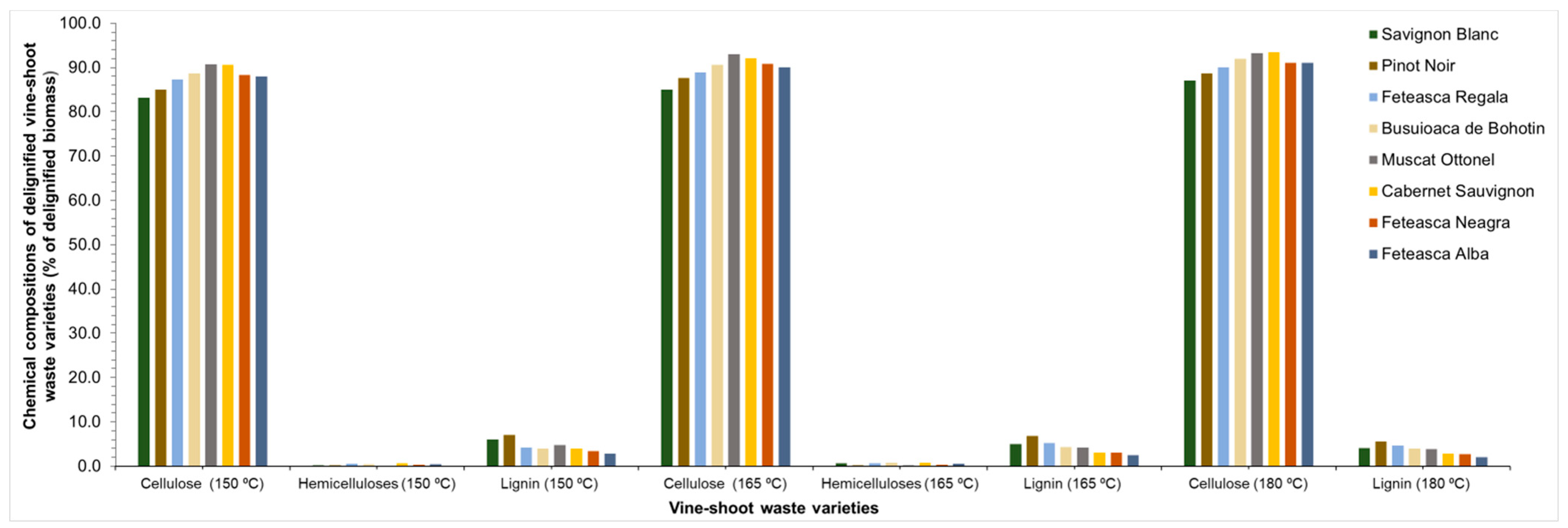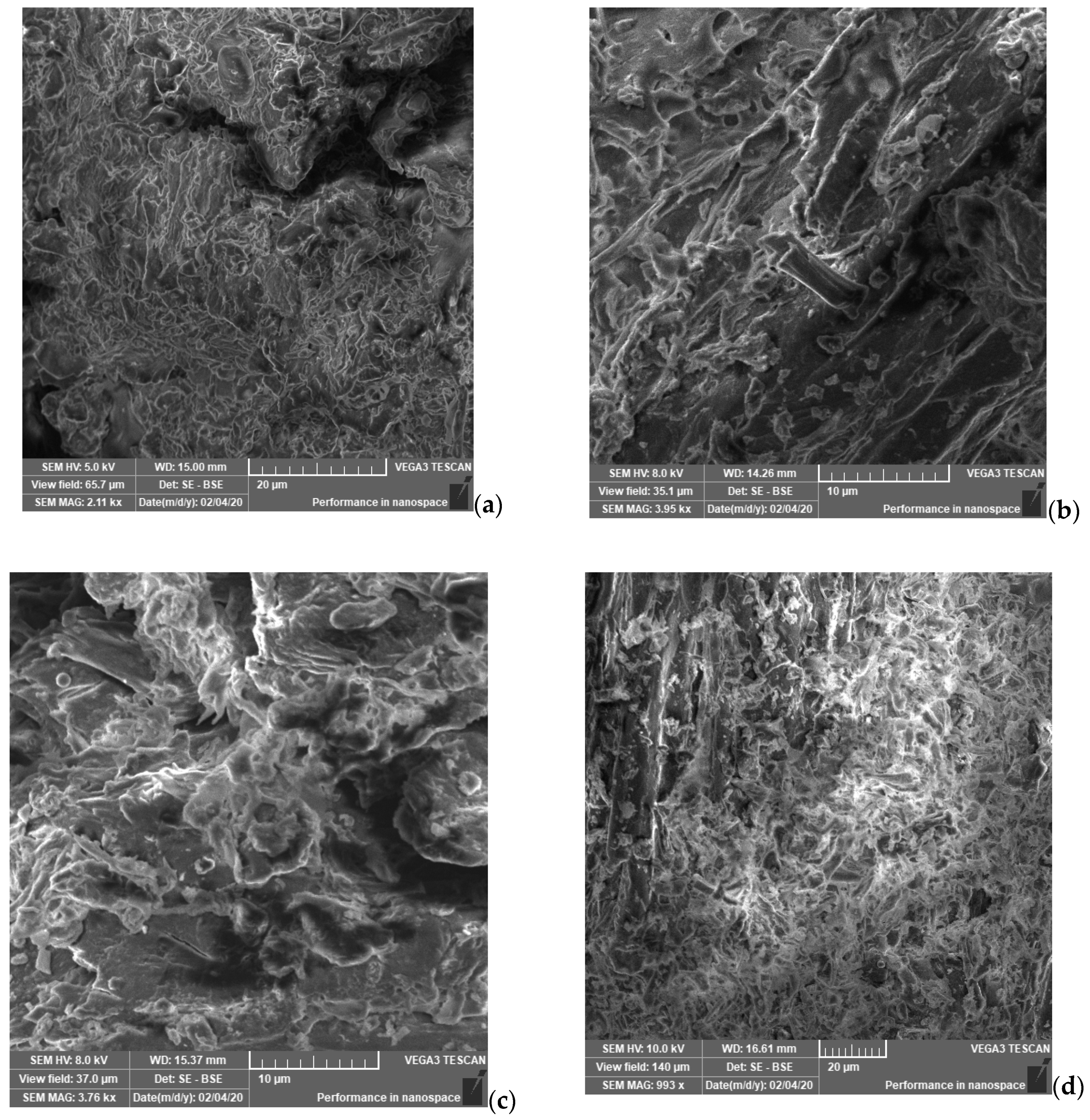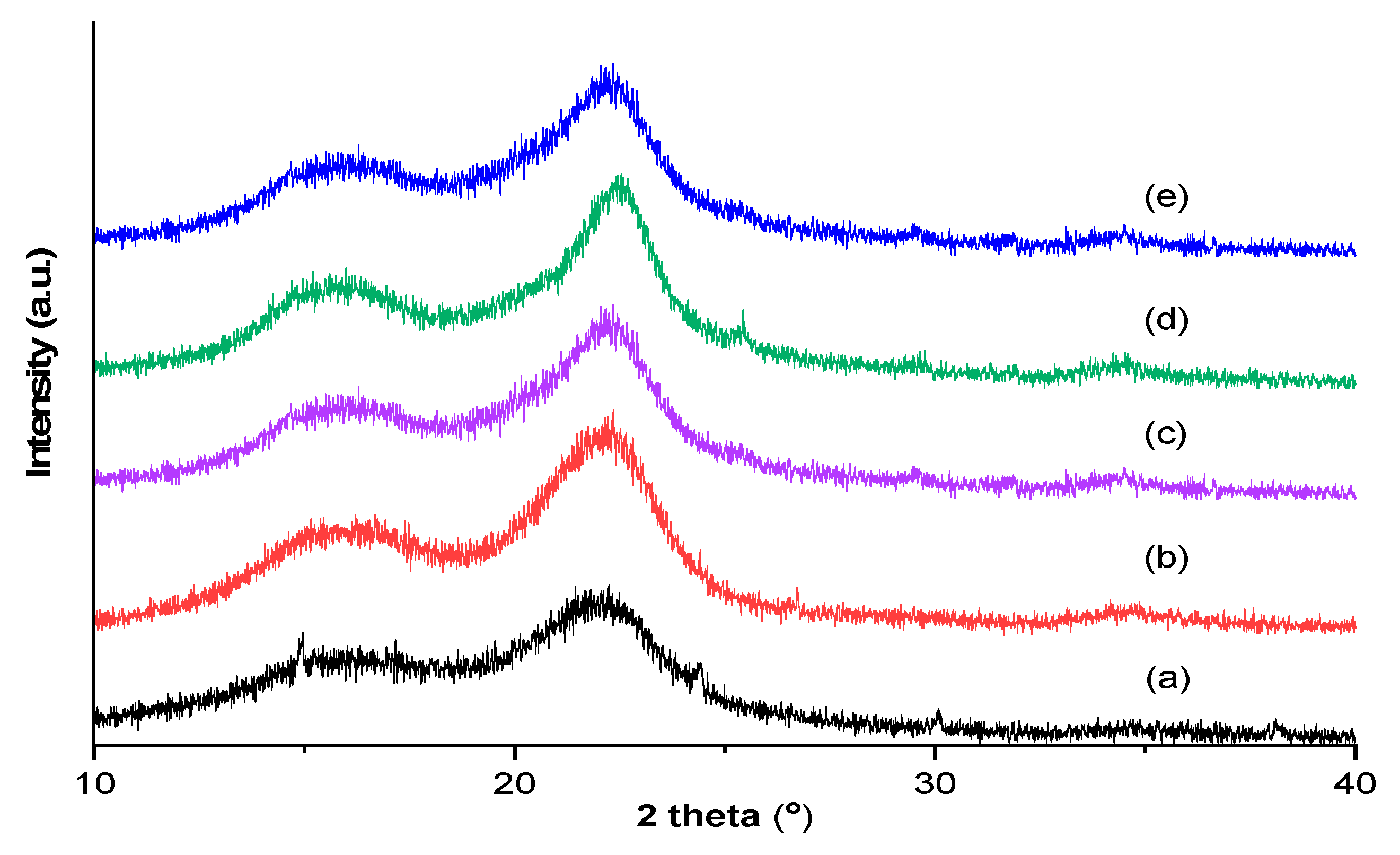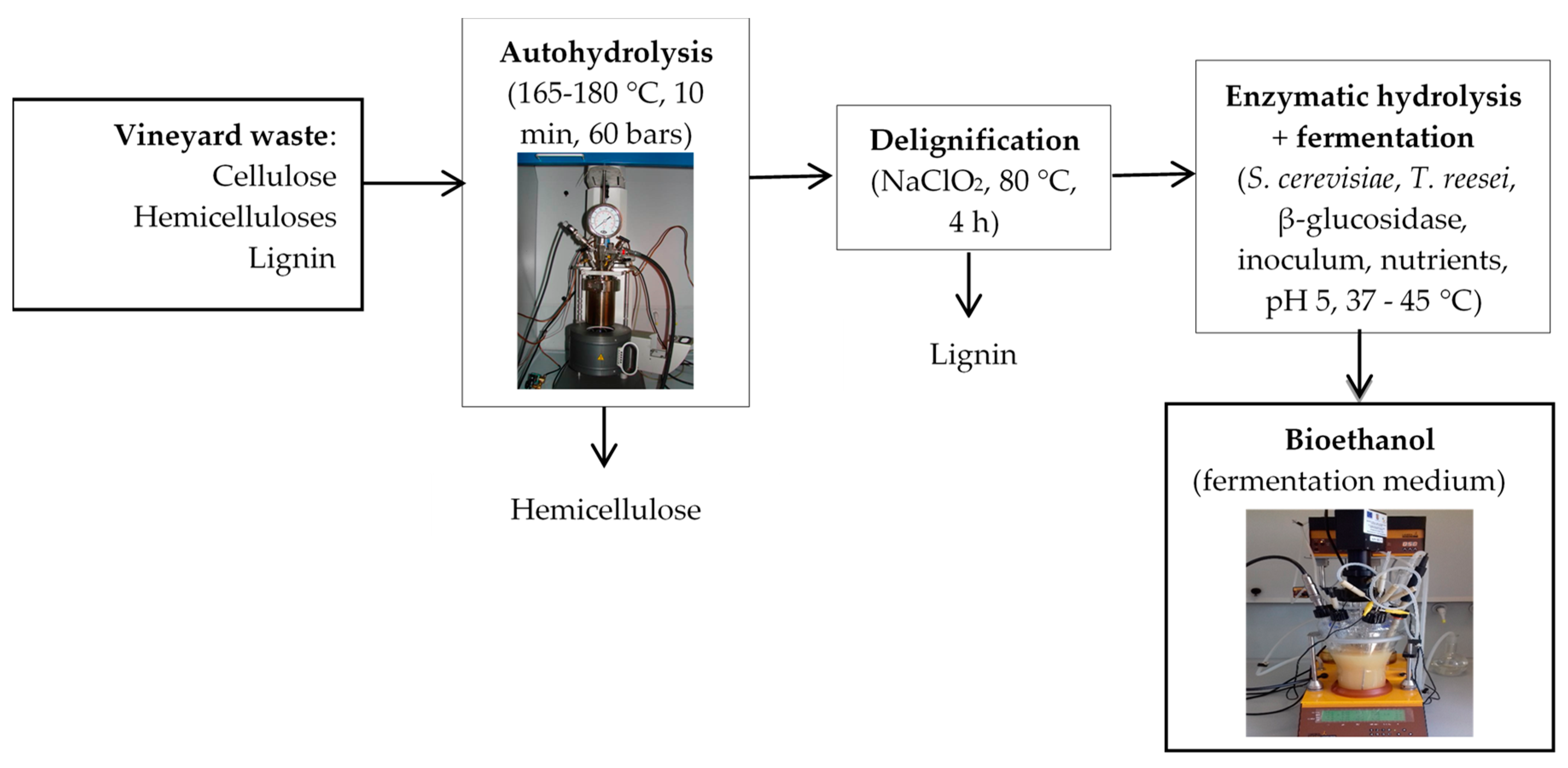Bioethanol Production from Vineyard Waste by Autohydrolysis Pretreatment and Chlorite Delignification via Simultaneous Saccharification and Fermentation
Abstract
:1. Introduction
2. Results and Discussion
2.1. Chemical Composition of Vine-Shoot Waste
2.2. Autohydrolysis Pretreatment of Vine-Shoot Wastes
Chemical Compositions of Liquid Samples
2.3. Delignification of Pretreated Vine-Shoot Waste
Mass Balance after Pretreatment and Delignification
2.4. Effect of Pretreatment and Delignification on the Vine-Shoot Waste Structure
2.4.1. SEM Analysis
2.4.2. XRD Analysis
2.5. Simultaneous Saccharification and Fermentation Process
2.6. Physico-Chemical Characteristics of Vine-Shoot Waste Variety
2.7. Results Characterization Using Principal Component Analysis
3. Materials and Methods
3.1. Chemicals and Reagents
3.2. Sample Description
3.3. Autohydrolysis Pretreatment
3.4. Acid Chlorite Delignification
3.5. Production of Bioethanol from Delignified Vine-Shoots Waste
3.5.1. Microorganism and Inoculum Preparation
3.5.2. Simultaneous Saccharification and Fermentation of Processed Vine-Shoots Waste
3.6. Chemical Characterization of Raw, Autohydrolysed and Delignified Materials
3.6.1. Cellulose, Hemicelluloses and Lignin Content for Raw, Autohydrolysed and Delignified Materials
3.6.2. Metals Determination in Untreated Vine-Shoot Waste Samples
3.6.3. Determination of Calorific Value
3.6.4. Determination of Hemicellulose Monosaccharides by GC-MS
3.6.5. Determination of HMF, Furfural, ASL and Acetic Acid from Hemicellulosic Fraction
3.6.6. Determination of Reducing Sugars from Enzymatic Hydrolysates
3.6.7. Determination of Ethanol Content
3.7. Structural Characterization of Pretreated and Delignified Vine-Shoot Waste
3.7.1. Scanning Electron Microscopy (SEM)
3.7.2. X-ray Diffraction (XRD)
3.8. Statistics
4. Conclusions
Author Contributions
Funding
Conflicts of Interest
References
- Yong, J.Y.; Klemeš, J.J.; Varbanov, P.S.; Huisingh, D. Cleaner energy for cleaner production: Modelling, simulation, optimization and waste management. J. Clean. Prod. 2016, 111, 1–16. [Google Scholar] [CrossRef]
- Geana, I.; Iordache, A.; Ionete, R.; Marinescu, A.; Ranca, A.; Culea, M. Geographical origin identification of Romanian wines by ICP-MS elemental analysis. Food Chem. 2013, 138, 1125–1134. [Google Scholar] [CrossRef] [PubMed]
- Dávila, I.; Robles, E.; Egüés, I.; Labidi, J.; Gullón, P. The biorefinery concept for the industrial valorization of grape processing by-products. In Handbook of Grape Processing By-Products—Suitable Solutions, 1st ed.; Charis, G., Ed.; Elsevier Books: Amsteram, The Netherlands, 2017; pp. 29–53. [Google Scholar]
- Venkitasamy, C.; Zhao, L.; Zhang, R.; Pan, Z. Grapes. In Integrated Processing Technologies for Food and Agricultural By-Products, 1st ed.; Pan, Z., Zhang, R., Zicari, S., Eds.; Elsevier Science Publishing Co Inc.: San Diego, CA, USA, 2019; pp. 133–163. [Google Scholar]
- Rani, J.; Indrajeet; Rautela, A.; Kumar, S. Biovalorization of winery industry waste to produce value-added products. In Biovalorization of Wastes to Renewable Chemicals and Biofuels, 1st ed.; Rathinam, N.K., Sani, R., Eds.; Elsevier: Oxford, UK, 2020; pp. 63–85. [Google Scholar]
- Nabais, J.M.V.; Laginhas, C.; Carrot, P.J.M.; Carrot, R. Thermal conversion of a novel biomass agricultural residue (vine shoots) into activated carbon using activation with CO2. J. Anal. Appl. Pyrol. 2010, 87, 8–13. [Google Scholar] [CrossRef]
- Kotarska, K.; Dziemianowicz, W.; Świerczyńska. Study of the sequential combination of bioethanol and biogas production from corn straw. Molecules 2019, 24, 4558. [Google Scholar] [CrossRef] [PubMed] [Green Version]
- Toor, M.; Kumar, S.S.; Malyan, S.K.; Bishnoi, N.R.; Mathimani, T.; Rajendran, K.; Pugazhendhi, A. An overview on bioethanol production from lignocellulosic feedstocks. Chemosphere 2020, 242, 125080. [Google Scholar] [CrossRef]
- Panahi, H.K.S.; Dehhaghi, M.; Aghbashlo, M.; Karimi, K.; Tabatabaei, M. Conversion of residues from agro-food industry into bioethanol in Iran: An under-valued biofuel additive to phase out MTBE in gasoline. Renew. Energy 2020, 145, 699–710. [Google Scholar] [CrossRef]
- Bhardawaj, N.; Kumar, B.; Agrawal, K.; Verma, P. Bioconversion of rice straw by synergistic effect of in-house produced ligno-hemicellolytic enzymes for enhance bioethanol production. Bioresour. Technol. Rep. 2020, 10, 100352. [Google Scholar] [CrossRef]
- Kumar, A.K.; Sharma, S. Recent updates on different methods of pretreatment of lignocellulosic feedstocks: A review. Bioresour. Bioprocess. 2017, 4, 7. [Google Scholar] [CrossRef] [PubMed] [Green Version]
- Procentese, A.; Raganati, F.; Olivieri, G.; Russo, M.E.; De La Feld, M.; Marzocchella, A. Agro food wastes and innovative pretreatments to meet biofuel demand in Europe. Chem. Eng. Technol. 2019, 42, 954–961. [Google Scholar] [CrossRef]
- Raj, N.; Shah, A. Comparative techno-economic analysis of steam explosion, dilute sulfuric acid, ammonia fiber explosion and biological pretreatments of corn stover. Bioresour. Technol. 2017, 232, 331–343. [Google Scholar]
- Dávila, I.; Gordobi, O.; Labidi, J.; Gullón, P. Assessment of suitability of vine shoots for hemicellulosic oligosaccharides production through aqueous processing. Bioresour. Technol. 2016, 211, 636–644. [Google Scholar] [CrossRef] [PubMed]
- Dávila, I.; Remón, J.; Gullón, P.; Labidi, J.; Budarin, V. Production and characterization of lignin and cellulose fractions obtained from pretreated vine shoots by microwave assisted alkali treatment. Bioresour. Technol. 2019, 289, 121726. [Google Scholar] [CrossRef] [PubMed]
- Pachón, E.R.; Mandade, P.; Gnansounou, E. Conversion of vine shoots into bioethanol and chemicals: Prospective LCA of biorefinery concept. Bioresour. Technol. 2020, 303, 122946. [Google Scholar] [CrossRef] [PubMed]
- Dávila, I.; Gullón, B.; Labidi, J.; Gullón, P. Multiproduct biorefinery from vine shoots: Bio-ethanol and lignin production. Renew. Energy 2019, 142, 612–623. [Google Scholar] [CrossRef]
- Rajha, H.N.; Kantar, S.E.; Afif, C.; Boussetta, N.; Louka, N.; Moroun, R.; Vorobiev, E. Selective multistage extraction process of biomolecules from vine shoots by a combination of biological, chemical, and physical treatments. C. R. Chim. 2018, 21, 581–589. [Google Scholar] [CrossRef]
- Xinxing, W.; Tang, T.; Huang, C.; Hunag, C.; Lai, C.; Yong, Q. The effect of exogenous ash on the autohydrolysis and enzymatic hydrolysis of wheat straw. Bioresour. Technol. 2019, 286, 121411. [Google Scholar]
- Cebreiros, F.; Clavijo, L.; Boix, E.; Ferrari, M.D.; Lareo, C. Integrated valorization eucalyptus sawdust within a biorefinery approach by autohydrolysis and organosolv pretreatments. Renew. Energy 2020, 149, 115–127. [Google Scholar] [CrossRef]
- Jin, K.; Liu, X.; Jiang, Z.; Yang, S.; Shang, L.; Ma, J. Delignification kinetics and selectivity in poplar cell wall with acidified sodium chlorite. Ind. Crops Prod. 2019, 136, 87–92. [Google Scholar] [CrossRef]
- Hubbell, C.A.; Ragauskas, A.J. Effect of acid-chlorite delignification on cellulose degree of polymerization. Bioresour. Technol. 2010, 101, 7410–7415. [Google Scholar] [CrossRef]
- Kovacs, E.; Scurtu, D.A.; Senila, L.; Cadar, O.; Dumitras, D.E.; Roman, C. Green protocols for the isolation of carbohydrtaes from vineyard vine-shoot waste. Anal. Lett. 2020. [Google Scholar] [CrossRef]
- Aditiya, H.B.; Mahlia, T.M.I.; Chong, W.T.; Nur, H.; Sebayang, A.H. Second generation bioethanol production: A critical review. Renew. Sust. Energ. Rev. 2016, 66, 631–653. [Google Scholar] [CrossRef]
- Dahnum, D.; Tasum, S.O.; Triwahyuni, E.; Nurdin, M.; Abimanyn, H. Comparison of SHF and SSF processes using enzyme and dry yeast for optimization of bioethanol production from empty fruit bunch. Energy Procedia 2015, 68, 107–116. [Google Scholar] [CrossRef] [Green Version]
- Çetin, E.S.; Altinöz, D.; Tarçan, E.; Baydar, N.G. Chemical compositions of grape canes. Ind. Crops Prod. 2011, 34, 994–998. [Google Scholar] [CrossRef]
- Senila, M.; Levei, E.A.; Senila, L.R.; Roman, M. Preliminary investigation concerning metals bioavailability in waters of Aries river catchment by using diffusive gradients in thin films technique. J. Chem. 2015, 1–8. [Google Scholar] [CrossRef]
- Senila, L.; Neag, E.; Torok, I.; Cadar, O.; Kovacs, E.; Tenu, I.; Roman, C. Vine shoots waste-new resources for bioethanol production. Rom. Biotechnol. Lett. 2020, 25, 1253–1259. [Google Scholar] [CrossRef]
- Senila, L.; Costiug, S.; Becze, A.; Kovacs, D.; Kovacs, E.; Scurtu, D.A.; Todor-Boer, O.; Senila, M. Bioethanol production from Abies Alba wood using adaptive neural fuzzy interference system mathematical modeling. Cell. Chem. Technol. 2020, 54, 53–64. [Google Scholar] [CrossRef]
- Jesus, M.S.; Romaní, A.; Genisheva, Z.; Teixeira, J.A.; Domingues, L. Integral valorization of vine pruning residue by sequential autohydrolysis stages. J. Clean. Prod. 2017, 168, 74–86. [Google Scholar] [CrossRef] [Green Version]
- Vallejos, M.E.; Zambon, M.D.; Area, M.C.; da Silva Curvelo, A.A. Low liquid-solid ratio fractionation of sugarcane bagasse by hot water autohydrolysis and organosolv delignification. Ind. Crops Prod. 2015, 65, 349–353. [Google Scholar]
- Senila, L.; Gog, A.; Senila, M.; Roman, C.; Silaghi-Dumitrecu, L. Analysis of carbohydrates obtained from wood by gas chromatography-mass spectrometry. Rev. Chim. 2011, 62, 59–64. [Google Scholar]
- Becker, M.; Liebner, F.; Rosenau, T.; Potthast, A. Ethoximation-silylation approach for mono- and disaccharide analysis and characterization of their identification parameters by GC/MS. Talanta 2013, 115, 642–651. [Google Scholar] [CrossRef]
- Herde, Z.D.; John, P.D.; Alvarez-Fonseca, D.; Satyavolu, J.; Burns, C.T. Stereoselective acetylation of hemicellulosic C5-sugars. Carbohydr. Res. 2017, 443, 1–14. [Google Scholar] [CrossRef] [PubMed]
- Prozil, S.O.; Evtuguin, D.V.; Lopes, L.P.C. Chemical composition of grape stalks of Vitis vinifera L. from red grape pomaces. Ind. Crops Prod. 2012, 35, 178–184. [Google Scholar] [CrossRef]
- Sánchez-Gómez, R.; Alonso, G.L.; Salinas, M.R.; Zalacain, A. Reuse of Vine-Shoots Wastes for Agricultural Purposes. In Handbook of Grape Processing By-products- Suitable Solutions, 1st ed.; Charis, G., Ed.; Elsevier Books: Amsteram, The Netherlands, 2017; pp. 79–104. [Google Scholar]
- Ruiz, H.A.; Conrad, M.; Sun, S.; Sanchez, A.; Rocha, J.M.; Romaní, A.; Castro, E.; Torres, A.; Rodríguez-Jasso, R.M.; Andrade, L.P.; et al. Engineering aspects of hydrothermal pretreatment: From batch to continuous operation, scale-up and pilot reactor under biorefinery concept. Bioresour. Technol. 2020, 299, 122685. [Google Scholar] [CrossRef] [Green Version]
- Boukir, A.; Fellak, S.; Doumenq, P. Structural characterization of Argania spinosa Moroccan wooden artifacts during natural degradation progress using infrared spectroscopy (ATR-FTIR) and X-Ray diffraction (XRD). Heliyon 2020, 5, e02477. [Google Scholar] [CrossRef] [PubMed] [Green Version]
- Achaby, M.E.; Miri, N.E.; Hannache, H.; Gmouh, S.; Ben youcef, H.; Aboulkas, A. Production of cellulose nanocrystals from vine shoots and their use for the development of nanocomposite materials. Int. J. Biol. Macromol. 2018, 117, 592–600. [Google Scholar] [CrossRef]
- Xu, F.; Shi, Y.-C.; Wang, D. X-ray scattering studied of lignocellulosic biomass: A review. Carbohydr. Polym. 2013, 94, 904–917. [Google Scholar] [CrossRef]
- Abdel-Banat, B.M.A.; Hoshida, H.; Ano, A.; Nonklang, S.; Akada, R. High-temperature fermentation: How can processes for ethanol production at high temperatures become superior to the traditional process using mesophilic yeast? App Microbiol Biotechnol. 2010, 85, 861–867. [Google Scholar] [CrossRef]
- Cotana, F.; Barbanera, M.; Foschini, D.; Lascaro, E.; Buratti, C. Preliminary optimization of alkaline pretreatment for ethanol production from vineyard pruning. Energy Procedia 2015, 82, 389–394. [Google Scholar] [CrossRef] [Green Version]
- Egüés, I.; Serrano, L.; Amendola, D.; Faveri, D.M.; Spigno, G.; Labidi, J. Fermentable sugars recovery from grape stalks for bioethanol production. Renew. Energy 2013, 60, 553–558. [Google Scholar] [CrossRef]
- Barbanera, M.; Lascaro, E.; Foschini, D.; Cotana, F.; Buratti, C. Optimization of bioethanol from steam exploded hornbeam wood (Ostya carpinifolia) by enzymatic hydrolysis. Renew. Energy 2018, 124, 136–143. [Google Scholar] [CrossRef]
- Zając, G.; Szyszlak-Bargłowicz, J.; Gołebiowski, W.; Szczepanik, M. Chemical characteristics of biomass ashes. Energies 2018, 11, 2885. [Google Scholar] [CrossRef] [Green Version]
- Ullah, A.; Ma, Y.; Li, J.; Tahir, N.; Hussain, B. Effective amendments on cadmium, arsenic, chromium and lead contaminated paddy soil for rice safety. Agronomy 2020, 10, 359. [Google Scholar] [CrossRef] [Green Version]
- Kim, P.; Hamilton, C.; Elder, T.; Labbé, N. Effect on non-structural organics and inorganics constituents of switchgrass during pyrolysis. Front. Energy Res. 2018, 6, 96. [Google Scholar] [CrossRef]
- Garcia, D.P.; Caraschi, J.C.; Ventorim, G.; Vieira, F.H.A.; Protásio, T.P. Assessment of plant biomass for pellet production using multivariate statistics (PCA and HCA). Renew. Energy 2019, 139, 796–805. [Google Scholar] [CrossRef]
- Antokiewicz, J.; Pelka, R.; Bik-Małodzińska, M.; Żukowska, G.; Gleń-Karolczyk, K. The effect of cellulose production waste and municipal sewage sludge on biomass and heavy metal uptake by a plant mixture. Environ. Sci. Pollut. Res. 2018, 25, 31101–31112. [Google Scholar] [CrossRef] [Green Version]
- Browning, B.L. Determination of acetyl and methoxyl groups. In Methods of Wood Chemistry; J. Wiley and Sons: New York, NY, USA, 1967; Volume 2, pp. 3–672. [Google Scholar]
- Teramoto, Y.; Lee, S.; Endo, T. Pretreatment of woody and herbaceous biomass for enzymatic saccharification using sulphuric acid-free ethanol cooking. Bioresour. Technol. 2008, 99, 8856–8863. [Google Scholar] [CrossRef]
- Senila, M. Real and simulated bioavailability of lead in contaminated and uncontaminated soils. J. Environ. Health Sci. Eng. 2014, 12, 108. [Google Scholar] [CrossRef] [Green Version]
- DIN 51900-1:2000, Determining the Gross Calorific Value of Solid and Liquid Fuels Using the Bomb Calorimeter, and Calculation of Net Calorific Value- Part 1: General Information. Available online: https://infostore.saiglobal.com/en-us/Standards/DIN-51900-1-2000-395724_SAIG_DIN_DIN_897685/ (accessed on 1 January 2000).
- Senila, L.; Gog, A.; Senila, M.; Roman, C.; Silaghi-Dumitrescu, L. Development of a GC-MS method for 5-hydroxymethylfurfural determination in wood after steam-explosion pretreatment. Rev. Chim. 2012, 63, 559–563. [Google Scholar]
- Senila, L.; Miclean, M.; Senila, M.; Roman, M.; Roman, C. New analysis method of furfural obtained from wood applying an autohydrolysis pretreatment. Rom. Biotech. Lett. 2013, 1, 7947–7955. [Google Scholar]
- Mackawa, E.; Ichizawa, T.; Koshijima, T. An evaluate of the acid-soluble lignin determination in analyses of lignin by sulphuric acid method. J. Wood Chem. Technol. 1989, 9, 549–567. [Google Scholar] [CrossRef]
- Miller, G.L. Use of dinitrosalicylic acid reagent for determination of reducing sugar. Anal. Chem. 1959, 31, 426–428. [Google Scholar] [CrossRef]
- Segal, L.; Creely, J.J.; Martin, A.E.; Conrad, C.M. Am empirical method for estimating the degree of crystallinity of native cellulose using the X-ray diffractometer. Text. Res. 1959, 29, 786–794. [Google Scholar] [CrossRef]
Sample Availability: Samples are available from the authors. |













| Temperature (°C) | Sauvignon Blanc | Pinot Noir | Feteasca Regala | Busuioaca de Bohotin | Muscat Ottonel | Cabernet Sauvignon | Feteasca Neagra | Feteasca Alba |
|---|---|---|---|---|---|---|---|---|
| Solid yield (% of raw material, dry biomass) | ||||||||
| 165 °C | 63.9 ± 7.6 | 62.6 ± 7.5 | 71.0 ± 8.0 | 70.2 ± 8.4 | 60.3 ± 6.6 | 65.3 ± 7.1 | 62.2 ± 6.7 | 66.2 ± 7.2 |
| 180 °C | 57.3 ± 6.8 | 56.04 ± 6.7 | 64.3 ± 7.7 | 68.6 ± 7.9 | 52.3 ± 5.7 | 56.1 ± 6.2 | 57.6 ± 6.3 | 59.3 ± 6.5 |
| Compositions of solid fraction resulted at 165 °C (% of autohydrolyzed biomass, dry biomass) | ||||||||
| Cellulose | 53.0 ± 6.3 | 57.0 ± 5.8 | 55.3 ± 6.6 | 56.0 ± 5.9 | 49.3 ± 5.9 | 57.3 ± 6.8 | 51.3 ± 6.1 | 51.9 ± 6.2 |
| Hemicelluloses | 1.0 ± 0.1 | 1.0 ± 0.1 | 1.0 ± 0.1 | 1.5 ± 0.1 | 1.2 ± 0.1 | 1.3 ± 0.1 | 1.6 ± 0.1 | 1.0 ± 0.1 |
| Lignin | 45.0 ± 5.4 | 41.0 ± 4.0 | 43.2 ± 5.1 | 40.7 ± 4.8 | 36.3 ± 4.3 | 32.4 ± 3.8 | 41.3 ± 4.3 | 42.6 ± 5.1 |
| Solid compositions | 99.0 ± 9.3 | 99.0 ± 8.0 | 99.5 ± 8.4 | 98.1 ± 9.1 | 86.8 ± 9.6 | 91.0 ± 9.5 | 94.2 ± 7.8 | 95.5 ± 8.6 |
| Compositions of solid fraction resulted at 180 °C (% of autohydrolyzed biomass, dry biomass) | ||||||||
| Cellulose | 49.0 ± 5.8 | 53.0 ± 6.0 | 51.3 ± 5.4 | 52.0 ± 4.8 | 45.3 ± 5.4 | 53.3 ± 6.0 | 47.3 ± 5.6 | 47.9 ± 5.2 |
| Hemicelluloses | - | - | 0.1 ± 0.0 | 0.2 ± 0.01 | - | - | 0.1 ± 0.0 | 0.1 ± 0.0 |
| Lignin | 41.0 ± 4.9 | 37.0 ± 4.4 | 39.2 ± 4.5 | 36.7 ± 3.8 | 32.3 ± 3.8 | 28.4 ± 3.0 | 37.3 ± 4.3 | 38.6 ± 3.5 |
| Solid compositions | 90.0 ± 9.8 | 90.0 ± 8.6 | 90.6 ± 7.6 | 88.8 ± 8.7 | 77.6 ± 7.5 | 81.7 ± 9.8 | 84.7 ± 8.6 | 86.6 ± 7.6 |
| Vine-Shoot Variety | Cellulose Recovered after Pretreatment/Delignification (% of Vine-Shoot Waste, Dry Biomass) | Lignin Recovered after Pretreatment/Delignification (% of Vine-Shoot Waste, Dry Biomass) | ||||||||||
|---|---|---|---|---|---|---|---|---|---|---|---|---|
| 150 °C | 165 °C | 180 °C | 150 °C | 165 °C | 180 °C | |||||||
| Sauvignon Blanc | 23.2 ± 2.5 | 19.0 ± 1.6 | 33.5 ± 2.8 | 21.7 ± 2.3 | 25.3 ± 2.7 | 20.0 ± 1.8 | 17.3 ± 1.9 | 1.6 ± 0.2 | 28.5 ± 2.6 | 1.3 ± 0.1 | 21.2 ± 2.5 | 0.9 ± 0.1 |
| Pinot Noir | 26.6 ± 2.3 | 22.1 ± 2.4 | 35.3 ± 2.0 | 24.7 ± 2.5 | 26.7 ± 2.3 | 22.7 ± 2.31 | 18.0 ± 1.3 | 1.6 ± 0.1 | 25.4 ± 3.1 | 1.9 ± 0.1 | 18.7 ± 1.9 | 1.0 ± 0.1 |
| Feteasca Regala | 29.9 ± 3.0 | 18.9 ± 1.8 | 39.1 ± 3.2 | 24.7 ± 2.6 | 29.9 ± 3.0 | 21.3 ± 2.0 | 22.4 ± 2.1 | 1.6 ± 0.2 | 30.5 ± 2.8 | 1.4 ± 0.1 | 22.8 ± 2.6 | 0.9 ± 0.2 |
| Busuioaca de Bohotin | 25.4 ± 2.2 | 19.4 ± 2.0 | 38.6 ± 3.5 | 22.3 ± 1.8 | 31.7 ± 2.6 | 19.1 ± 2.7 | 17.3 ± 1.7 | 1.4 ± 0.1 | 28.0 ± 2.3 | 1.1 ± 0.1 | 22.4 ± 2.4 | 0.9 ± 0.1 |
| Muscat Ottonel | 16.1 ± 1.6 | 20.0 ± 1.8 | 25.8 ± 2.8 | 23.3 ± 1.6 | 28.4 ± 2.4 | 20.3 ± 2.4 | 11.1 ± 2.9 | 1.3 ± 0.2 | 19.0 ± 1.7 | 1.1 ± 0.1 | 13.1 ± 1.8 | 0.8 ± 0.2 |
| Cabernet Sauvignion | 22.9 ± 2.3 | 20.1 ± 1.8 | 34.0 ± 3.0 | 24.3 ± 2.6 | 24.4 ± 2.6 | 20.9 ± 1.7 | 11.1 ± 1.3 | 1.6 ± 0.1 | 19.3 ± 2.1 | 0.8 ± 0.3 | 13.0 ± 1.6 | 0.9 ± 0.1 |
| Feteasca Neagra | 21.1 ± 2.1 | 18.2 ± 1.5 | 30.1 ± 2.9 | 20.8 ± 2.4 | 23.1 ± 1.8 | 18.0 ± 2.3 | 16.4 ± 1.8 | 1.5 ± 0.1 | 24.2 ± 2.0 | 0.7 ± 0.4 | 18.2 ± 2.2 | 0.8 ± 0.2 |
| Feteasca Alba | 21.4 ± 2.5 | 18.1 ± 1.9 | 32.8 ± 3.1 | 20.0 ± 2.2 | 24.6 ± 2.1 | 18.2 ± 1.8 | 17.1 ± 2.0 | 1.1 ± 0.1 | 26.9 ± 2.4 | 0.6 ± 0.2 | 19.8 ± 2.3 | 0.9 ± 0.1 |
| Sample | χc (%) | CrI (%) | Dc (nm) |
|---|---|---|---|
| (a) Untreated vine-shoot waste | 44.5 | 78.6 | 3.71 |
| (b) Autohydrolized and delignified vine-shoot waste (at 165 °C) | 46.6 | 65.9 | 3.61 |
| (c) Autohydrolized vine-shoot waste at 150 °C | 45.0 | 71.3 | 4.52 |
| (d) Autohydrolized vine-shoot waste at 165 °C | 44.2 | 63.6 | 4.87 |
| (e) Autohydrolized vine-shoot waste at 180 °C | 41.0 | 61.0 | 5.24 |
| Raw Material | Pretreatment Conditions | Concentration of Ethanol | Reference |
|---|---|---|---|
| Vine pruning residue (from Portugal) | Autohydrolysis I two stages: (a) 180 °C, 60 min 6:1 (solid:liquid ratio) and (b) 180–200 °C, 30–40 min-SSF process | 13.1 kg ethanol 100 kg−1 vine punning | [30] |
| Vineyard pruning (from Italy) | Alkaline pretreatment (NaOH), enzymatic hydrolysis | 202 g glucose kg−1 of raw material | [42] |
| Grape stalks (from Bonarda and Barbera red cultivars, Italy) | Autohydrolysis 121 °C, acid hydrolysis with 2% H2SO4 and fermentation with Debaryomyces nepalensis NCYC 1026 | 20.84 g L−1 ethanol (0.35 g g−1 monomeric sugars) | [43] |
| Hornbeam wood (Ostrya carpinifolia) | Steam explosion (230 °C, 28 bar), | 25 L ton−1 dry material | [44] |
| Vine-shoot waste (from Romania) | Autohydrolysis (150, 165, 180 °C), delignification with sodium chlorite, SSF process | 3.0–6.0 kg ethanol 100 kg−1 vine shoot waste | This study |
| Component | Sauvignon Blanc | Pinot Noir | Feteasca Regala | Busuioaca de Bohotin | Muscat Ottonel | Cabernet Sauvignon | Feteasca Neagra | Feteasca Alba |
|---|---|---|---|---|---|---|---|---|
| Na | 252 ± 5.3 | 177 ± 6.2 | 363.8 ± 5.8 | 185 ± 4.3 | 191 ± 3.8 | 178 ± 6.0 | 200 ± 5.3 | 166 ± 4.2 |
| Mg | 840 ± 4.3 | 719.1 ± 5.2 | 1255 ± 6.0 | 630 ± 5.6 | 776 ± 6.5 | 865 ± 5.1 | 861 ± 4.2 | 696 ± 5.0 |
| K | 3414 ± 5.2 | 2282.6 ± 4.8 | 3241 ± 5.6 | 2209 ± 6.2 | 1788 ± 5.6 | 2359 ± 4.9 | 3210 ± 5.1 | 3356 ± 5.9 |
| Ca | 2862 ± 6.2 | 2011.5 ± 5.4 | 3450 ± 6.6 | 1782 ± 5.3 | 1622 ± 4.8 | 2668 ± 5.7 | 2159 ± 6.0 | 2018 ± 4.7 |
| Al | 67.0 ± 4.1 | 52.2 ± 3.2 | 60.7 ± 2.2 | 41.7 ± 4.0 | 56.8 ± 3.8 | 56.5 ± 3.4 | 53.5 ± 2.9 | 58.6 ± 3.7 |
| CV | 1.56 ± 0.08 | 1.3 ± 0.05 | 1.7 ± 0.04 | 1.44 ± 0.05 | 1.56 ± 0.09 | 1.57 ± 0.08 | 1.59 ± 0.06 | 1.6 ± 0.05 |
| Variable | PC1 | PC2 | PC3 | PC4 |
|---|---|---|---|---|
| Eigenvalue | 7.96 | 3.77 | 2.94 | 2.47 |
| Variability (%) | 39.80 | 18.84 | 14.72 | 12.33 |
| Cumulative (%) | 39.80 | 58.65 | 73.36 | 85.69 |
| Factor loadings after varimax rotation | ||||
| Ash | 0.925 | 0.082 | 0.066 | 0.161 |
| Extractable | −0.001 | −0.595 | −0.570 | 0.010 |
| Lignin | −0.033 | 0.226 | 0.918 | 0.123 |
| Cellulose | 0.508 | 0.216 | −0.083 | −0.427 |
| Hemicelluloses | −0.042 | 0.204 | 0.031 | 0.898 |
| C | 0.141 | −0.806 | −0.160 | 0.061 |
| Protein | 0.204 | 0.833 | −0.206 | 0.463 |
| CV | 0.450 | −0.052 | 0.224 | 0.345 |
| Bioethanol | −0.233 | −0.614 | −0.199 | −0.451 |
| Fe | 0.590 | 0.762 | 0.204 | 0.003 |
| Cu | 0.665 | 0.426 | −0.259 | 0.486 |
| Zn | 0.174 | 0.785 | 0.344 | −0.121 |
| Na | 0.516 | 0.244 | 0.797 | 0.057 |
| Mg | 0.731 | −0.013 | 0.607 | −0.021 |
| K | 0.429 | 0.130 | 0.168 | 0.830 |
| Ca | 0.653 | 0.209 | 0.532 | 0.295 |
| Mn | −0.951 | 0.080 | −0.036 | −0.037 |
| Al | 0.775 | 0.455 | −0.133 | 0.288 |
| Sr | −0.079 | 0.003 | 0.970 | 0.023 |
| Ba | 0.132 | −0.250 | 0.055 | 0.790 |
© 2020 by the authors. Licensee MDPI, Basel, Switzerland. This article is an open access article distributed under the terms and conditions of the Creative Commons Attribution (CC BY) license (http://creativecommons.org/licenses/by/4.0/).
Share and Cite
Senila, L.; Kovacs, E.; Scurtu, D.A.; Cadar, O.; Becze, A.; Senila, M.; Levei, E.A.; Dumitras, D.E.; Tenu, I.; Roman, C. Bioethanol Production from Vineyard Waste by Autohydrolysis Pretreatment and Chlorite Delignification via Simultaneous Saccharification and Fermentation. Molecules 2020, 25, 2606. https://doi.org/10.3390/molecules25112606
Senila L, Kovacs E, Scurtu DA, Cadar O, Becze A, Senila M, Levei EA, Dumitras DE, Tenu I, Roman C. Bioethanol Production from Vineyard Waste by Autohydrolysis Pretreatment and Chlorite Delignification via Simultaneous Saccharification and Fermentation. Molecules. 2020; 25(11):2606. https://doi.org/10.3390/molecules25112606
Chicago/Turabian StyleSenila, Lacrimioara, Eniko Kovacs, Daniela Alexandra Scurtu, Oana Cadar, Anca Becze, Marin Senila, Erika Andrea Levei, Diana Elena Dumitras, Ioan Tenu, and Cecilia Roman. 2020. "Bioethanol Production from Vineyard Waste by Autohydrolysis Pretreatment and Chlorite Delignification via Simultaneous Saccharification and Fermentation" Molecules 25, no. 11: 2606. https://doi.org/10.3390/molecules25112606






